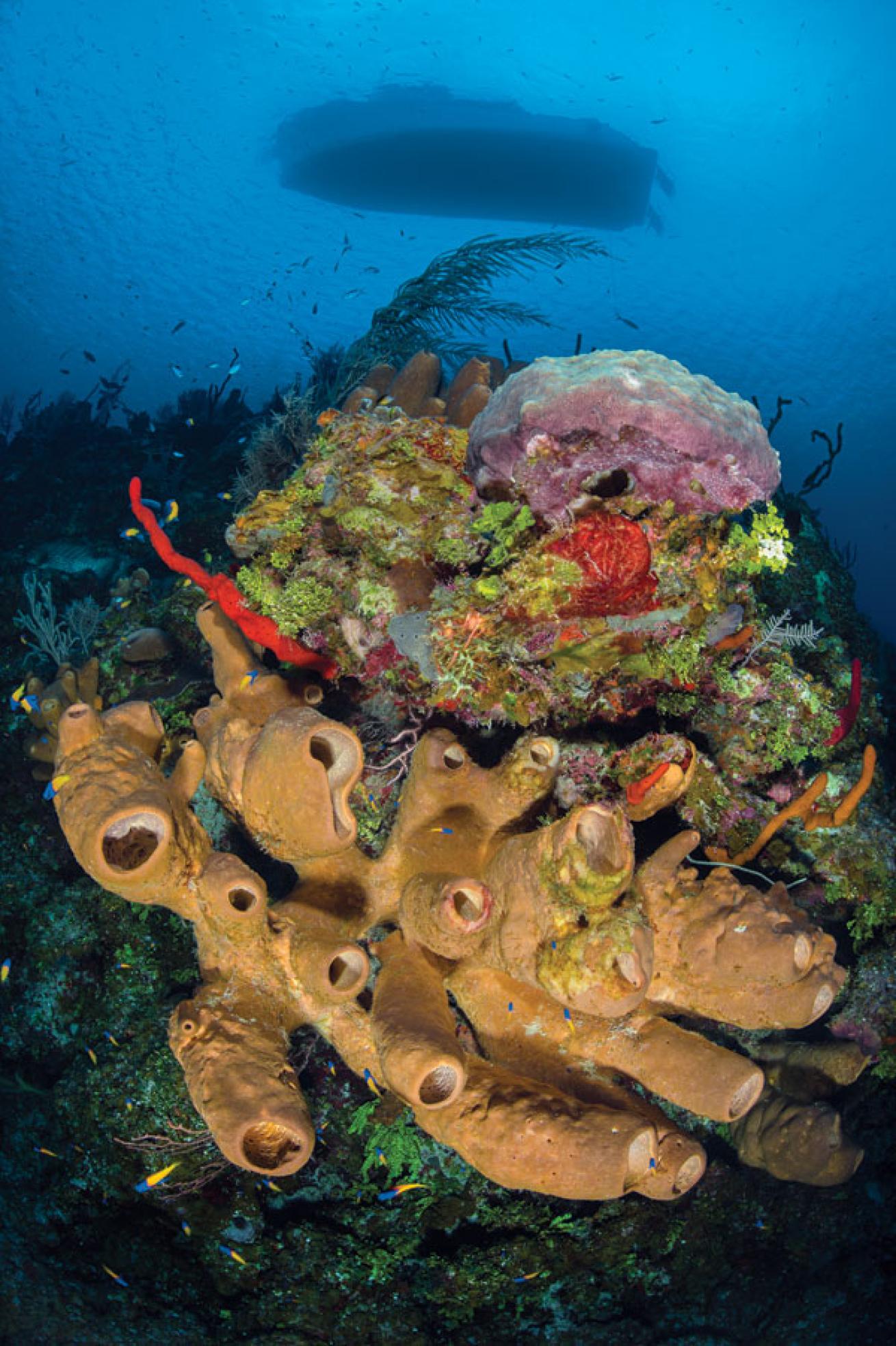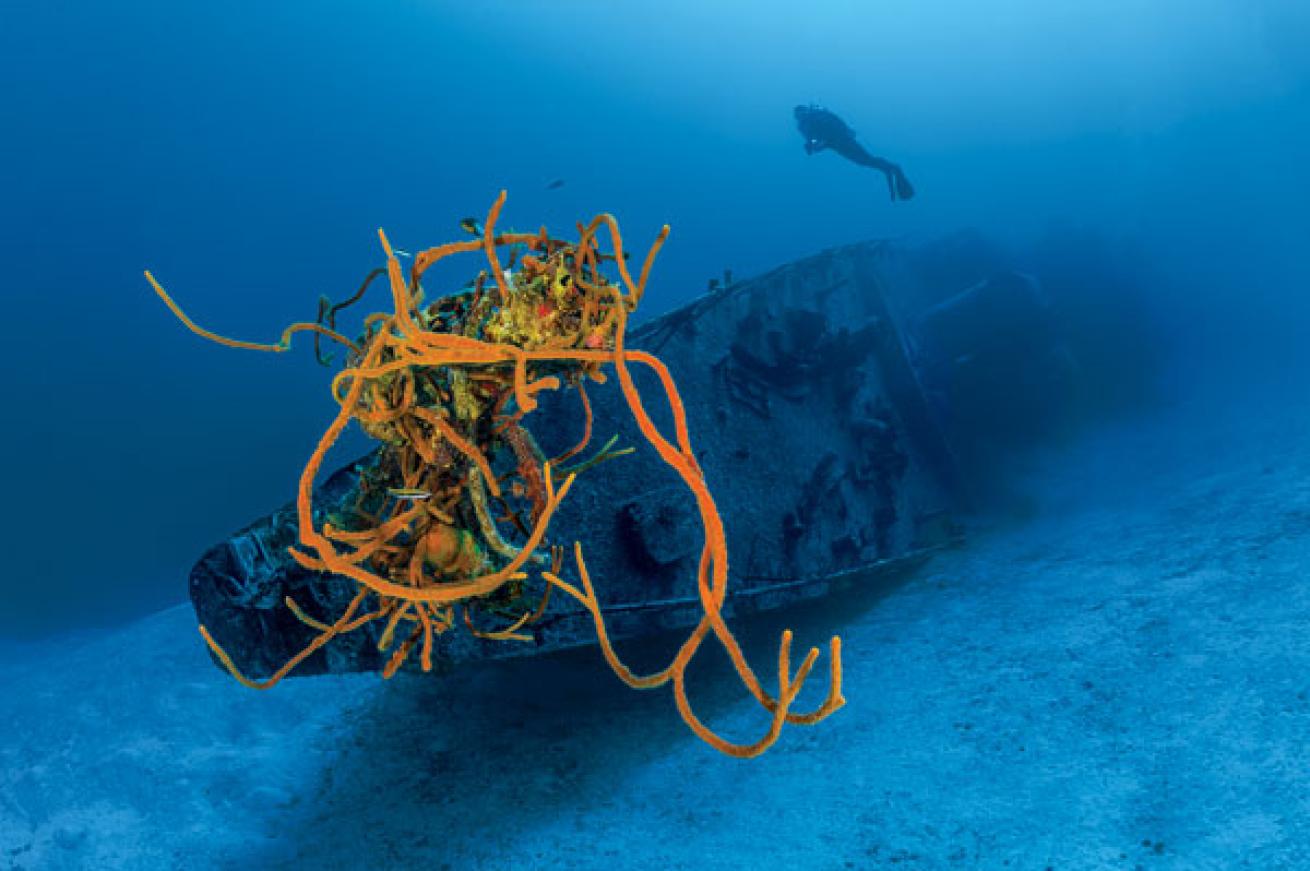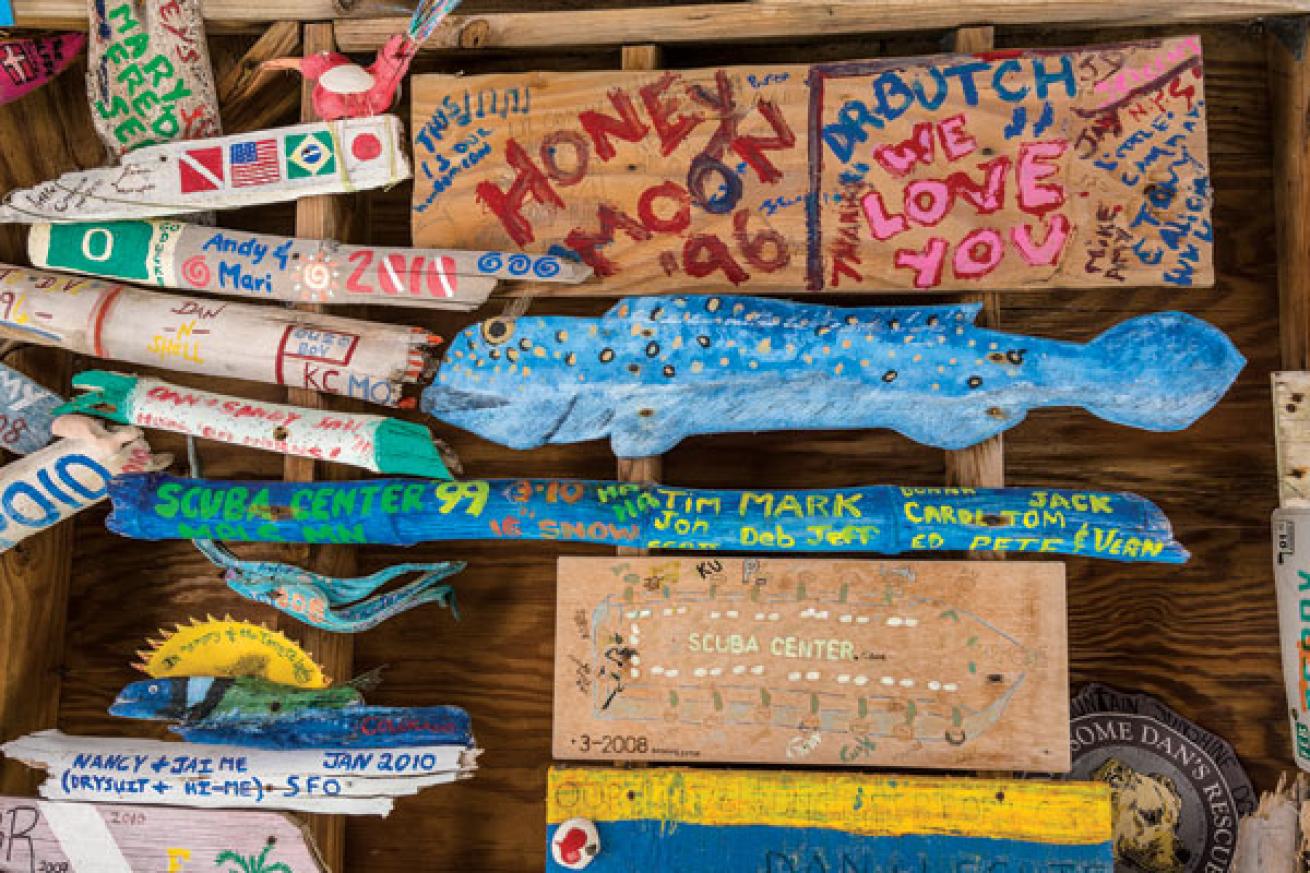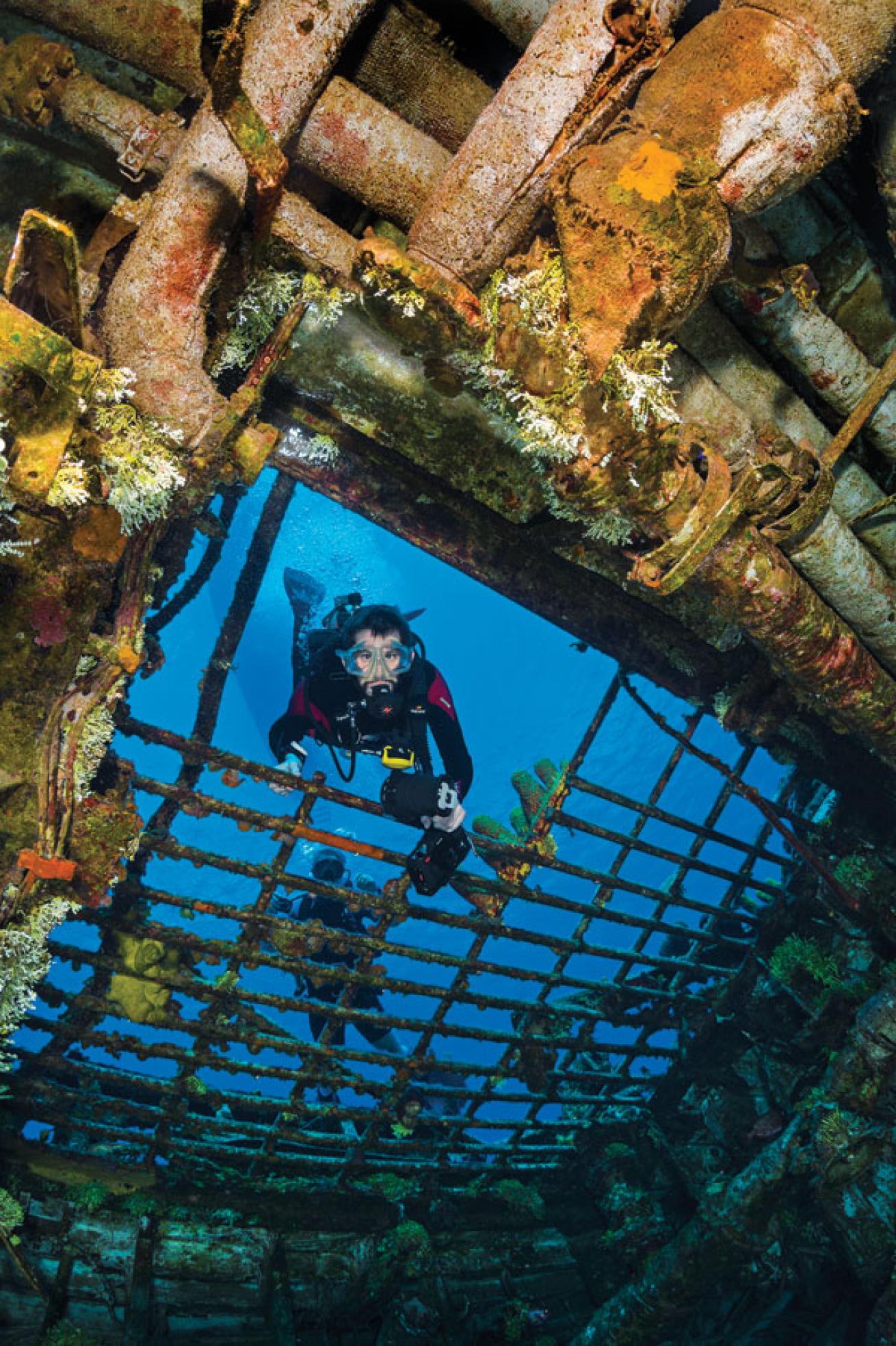Scuba Diving in Cayman Islands' Sister Islands: Little Cayman and Cayman Brac

Alex MustardLittle Cayman’s Bloody Bay Wall is one of the island’s most iconic sites, and one of the world's most popular dives.
I’ve been on Little Cayman two hours when I learn it nurtures one of the most bizarre animal behaviors I’ve ever encountered. From my room at Little Cayman Beach Resort, I travel only as far as the poolside bar to witness it — lured by the promise of mahimahi tacos, I take a seat and watch the couple next to me review their GoPro footage.
A hand, palm flat, stretches toward a Nassau grouper 10 feet away. The 3-foot-long fish beelines in, stroking itself against the diver’s hand. Then it seems to draft right of the camera — as if awaiting the diver’s next move. And the really odd thing is, nobody is feeding this fish.
More important, nobody is pulling these fish from Bloody Bay Marine Park, which encompasses the famous wall along Little Cayman’s north coast. No local would dare to target a Nassau grouper.
Brice Semmens, assistant professor of marine biology at the Scripps Institution of Oceanography in San Diego, California, has traveled here every February for the past decade to study the species’ annual spawn. His work is part of the ongoing Grouper Moon project, organized through the Reef Environmental Education Foundation. Semmens knows the community. The island’s population is too small to fill a commercial jet, and most residents are connected to the dive industry in some way.
“You don’t want to be the guy fishing on Bloody Bay Wall — if you get seen, everybody will know about it,” he says.
Between the protections in place to safeguard the species’ spawning and the lack of fishing, the numbers of this threatened animal have rebounded on Little Cayman. In 2012, Semmens and his team estimated that the population had risen to 4,000 — up from 2003’s estimate of 1,500.
But the numbers don’t explain why this fish has become so cozy with divers.

Alex MustardA Nassau grouper (Epinephelus striatus) is cleaned by gobies (Gobiosoma genie). Groupers are making a strong comeback, and Little Cayman is home to one of the last great reproductive populations of this endangered species.
In the morning, I learn that, when it comes to Nassau grouper, pointing isn’t rude — it’s helpful. We moor at Mixing Bowl, which is easily the most famous of Bloody Bay Wall’s offerings. It delivers high drama via a sheer wall cascading into the abyss, plus a plateau teeming with macro wonders. Every tenth yellowhead jawfish squirrel-cheeks a pouch of eggs, and rice-grain-size head shield slugs inch their way across the sand. We’ve already made a loop past all of this when a Nassau grouper appears.
This fish seems somehow stuck in place at the end of a swim-through tunnel, as if bound by a shock collar. It has nosed out only so far. Then it spies our dive guide, Anoush Dadian. It scoots past every diver and stops just short of her. The fish rolls its eyes to study her, then swims a few feet back toward the cave. It wants her to follow. She does. So do I.
At the opening of the swim-through, the fish aims its nose at a lionfish, then looks back at Dadian. She doesn’t have a spear, so she just shrugs, and eventually the grouper catches on.
In a few minutes, I’m even more amazed. This time, Dadian shows her friend where he might find a meal. She points to a lionfish out carousing in open water, not tucked under a ledge. The grouper dive-bombs the spiny predator but misses. But the fish understood the gesture of pointing.
Back on the boat, I learn that this behavior is called joint attention. Before becoming a scuba instructor, Dadian had worked with autistic kids unable to track a directing finger. “Isn’t it amazing that these fish can do this?” she asks.
I’m still turning this over while I lie in bed that night, pondering the fact that this fish that so often finds itself between slices of bun is as clever as a retriever, an animal we would never eat. And yet, how many people are aware that this fish is the bird dog of the reefs?

Alex MustardRope sponges festoon the Tibbetts’ bow. The wreck, located off Cayman Brac, is the only Russian warship that divers can explore in the Western hemisphere.
Diving with Nassau Grouper on Little Cayman
A few days later, I meet the head trainer of sorts — the woman who taught these fish to trust divers. Dottie Benjamin stands 5'4", but her personality could fill stadiums. She brings out the energy of any group.
Over dinner at Pirates Point, she tells me that this island has a long history of Nassau grouper that act more like reef pets than wild animals. One of the first obliging pairs was called Ben and Jerry, residents at the dive site Marilyn’s Cut.
“You could carry Ben like a football and put a hat on his head,” says Benjamin in her slightly Southern twang. Before she arrived on island, in 1997, another instructor had been spending time with the fish, getting them comfortable with interaction.

Alex MustardDriftwood painted by visiting divers in the bar at Little Cayman Beach Resort.
Benjamin says she put in the most time with a duo known as Benji and Mini Me, who made their home at Donna’s Delight, another spot on the wall.
“In the beginning, Mini Me wouldn’t let you touch him,” she says. But Benji, the older and bigger fish, had already learned to trust divers, and would fin at their heels as they flushed squirrelfish from the reef. Benjamin says it took about a year before Mini Me would follow suit, happy to score handouts.
With time, Mini Me became the more competitive fish, faster to respond to divers.
Benjamin says she put in the most time with a duo known as Benji and Mini Me, who made their home at Donna’s Delight, another spot on the wall.
“In the beginning, Mini Me wouldn’t let you touch him,” she says. But Benji, the older and bigger fish, had already learned to trust divers, and would fin at their heels as they flushed squirrelfish from the reef. Benjamin says it took about a year before Mini Me would follow suit, happy to score handouts.
With time, Mini Me became the more competitive fish, faster to respond to divers.
By 2010, the lionfish invasion had spread to Little Cayman and Cayman Brac, and teams of divers began culling the reefs weekly to dispose of the nasty predators that devour up to 10 times their body weight daily. Benjamin began to wonder whether grouper would eat lionfish, hoping that with training, they would independently hunt this alien threat.
If any of them might, she figured it would be Mini Me.
So she speared a baby lionfish — appetizer size. “We waved it in front of Mini Me and waited. Then he swallowed it. He spit it out, and he swallowed it again. That was it.”
Benjamin kept working with the grouper, training him to eat a live lionfish from a net.
“He’d attack it like a dog with a toy.” And so the behavior progressed — a bit. The grouper came to understand that dive guides, or anyone carrying a spear, could make their next meal a happy one. But there the experiment stalled. The grouper haven’t bridged the gap to gulp lionfish unaided, stuck in the phase of following divers whom they hope will feed them dinner. Lionfish are culled only once a week now, on a trip separate from paying guests, so that piece of the equation has become sporadic.

Alex MustardThe Tibbetts is located in a sandy area with excellent visibility.
Meeting Lappy
On my last dive day on Little Cayman, I meet Lappy. Benjamin takes the morning group to Great Wall West. Even as we first drop down, this grouper has heard the boat motor and is waiting, like a dog sitting on the foyer rug, tail wagging.
I’m not sure which is the more entertaining spectacle: Benjamin exaggeratingly pantomiming swimming to entice her reef dog to follow, or the way the grouper leaps into action when he sees his mistress on the move.
Lappy follows Benjamin for 60 or 70 yards, then retreats back to the mooring area. These animals are territorial, sticking more or less to their staked claims, staying at the edge of their homes, waiting. We continue on, dropping down along the wall. We cruise past a green turtle, traffic coming from the other direction.
When we make it back to Lappy’s den, Benjamin swims and peers under ledges, the grouper back in tow; Benjamin is demonstrating how loyally this animal follows her. As the dive clock winds down, she returns to the boat, but hands me her spear. She knows I have no intention of skewering any sushi, but it’s a tool these fish already understand.
So I swim a few yards away. I duck my head under a ledge, and when I pull my noggin out, I have company. This saucer-eyed guest is hungry, and I suddenly feel guilty, like a dinner-party hostess who has just realized the larder is bare. Luckily, Nassau grouper are pretty forgiving.
I make small laps around the brain coral boulders and patch reef, all the while with Lappy in tow. I know this fish is only trotting alongside me because Benjamin is gone and I hold this tool, but still, I’m incredibly honored. Right now, I feel a connection like none other I have known on the reefs. It’s hard not to anthropomorphize when looking into the eyes of this fish. I swear I see emotion. It’s as if this fish is raising its eyebrows, saying, “Really?” each time I dart under a ledge to see if it will follow suit. It seems like we’re having a conversation.
When my gauges persuade me to say goodbye, I’m choked up. I ascend as Lappy stays put, watching me go.
On the boat, I climb out of my gear while Benjamin sits beside me. I know she knows what’s going through my head. I ask how they can tell her from all the other divers. She says that even on days she doesn’t tote the spear, they still come right to her, not anybody else. “I don’t know how they do it,” she says.
I think of my own dog, Daisy, a boxer who is always happy to see me, even when I return from three- and four-week abandonments. I come home, and she bounds up to be by my side. And once again, life just feels brighter.

Alex MustardA Nassau grouper on Bloody Bay Wall. It's estimated that their population is now up to 4,000, from 1,500 in 2003.
Cayman Brac
It’s my first dive at Cayman Brac, and already we’re at the island’s most famous site, M/V Captain Keith Tibbetts, a downed Russian anti-submarine warfare frigate — but we’re here only because the wind has made all other options too rough. Here on Brac — as everyone calls it — the local scuba operation dives both sides of the cigar-thin, 12-mile-long island. That makes for a big variety of topography and a lot to showcase: sharks, swim-throughs and gently sloping walls on the south side; proper walls and shallow patch reefs on the north. The dive staff at Reef Divers, the scuba operation that’s part of Brac Reef Beach Resort, makes sure every guest who wants it gets the chance to see this metal beauty, but crafts the schedule like a puzzle, piecing in a bit of everything when conditions allow.
It’s a setup unlike that of Little Cayman, where Bloody Bay Wall is the star attraction. Brac’s charms are more spread out: a little less obvious, a little less attention seeking. If the Caymans were the Bradys, this sister is definitely Jan.
As for the Tibbetts, at 330 feet long it’s an asset to be proud of. I keep close to instructor Jeff Varga after entering the water. He covered a lot of ground in his briefing, and I want to cover every bit as much during our dive.
We start at the stern, immediately ducking into darkness: a corridor. To our left, the sun-dappled engine room is cordoned off by a fat metal grate. We slip past a panel of gauges, then kick for a spell, long enough that we lose all light. This gives me an appreciation for the immensity of this ship. We pop out, swim a bit, and come across a set of guns — always a little odd to see ammunition decorated with yellow tube sponges, recalling the 1967 anti-Vietnam War image of a gun barrel bearing a carnation.
Want to see more of the Tibbetts? Watch a video of this stunning wreck!

Alex MustardA secretary blenny (Acanthemblemaria maria) peeks out from its coral home.
Finding Small Treasures
On the way back to the dive boat, Varga points at the sand. I see nothing. I figure I must have missed something in the briefing until he holds his hand flat to me. He wants to show that a flapping dingbat is a real thing, not a character on a computer, or something only the narced would appreciate. It’s a minuscule sea slug, roughly the size of a vitamin.
I remember the pre-dive words of Hellen Armstong, the other instructor on today’s trip: “They’re best described as a mini croissant.” Sure enough, when this life form feels a change in environment, it unfurls its wings and tries to fly to safety.
As it flings its slight self into the water column, with this massive warship as backdrop, I realize that diving Brac is an exercise in scale, with small wonders set against big landscapes.
The next morning we start the day at Tombstone, named for the cemetery that serves as a marker on shore. Running north to south, the reef is a series of stubby coral fingers. A few sponges have bite marks nipped from their bases — clearly turtles frequent this spot. I slow to look for them, and a seahorse mentioned in the briefing. What I end up watching is Katie, one half of the couple I’ve buddied with. She’s peering into every barrel sponge, like a kid lifting lids on cookie jars. When she waves us over, it’s for good reason. A channel-clinging crab with a carapace the size of a pie has nestled inside.
We make more headway along the reef when I find myself watching a brittle star — an ordinary, yes-I’ve-seen-thousands-of-them brittle star. But I’ve never studied one on the move. Just as an octopus avoids detaching all of its arms at once from hard structure, this little guy wobbles onward but keeps one pipe-cleaner limb touching coral at all times. Its many undulating arms remind me of a Hindu deity. The action is so mesmerizing that when I spy a green turtle coming in for a landing, I pause but go back to enjoying my echinoderm. Sure, the turtle is the animal most divers would choose to observe, but for now, I’m happy here, watching an everyday behavior that somehow feels like a big discovery.
Dive Now
Weather: Expect daytime highs in the 70Fs in winter, and in the mid- to high 80Fs in the summer.
Dive Conditions: Temperatures drop into the high 70Fs in winter and peak in the low 80Fs in summer. Visibility varies from 80 to 200 feet, with peak water clarity occurring during the calm summer months.
Currency: The Cayman dollar (CI$) is worth more than the U.S. dollar. The fixed rate is CI$1 to US$1.25. U.S. dollars (and major credit cards) are widely accepted, but expect change in local currency.
Electricity: 110 volts, 60 cycles, the same as the United States and Canada.
Dive Resorts and Operators
Cayman Brac Beach Resort | Little Cayman Beach Resort | Southern Cross Club
For more information on diving the Cayman Islands, check out the CAYMAN DIVE GUIDE.










